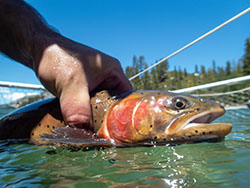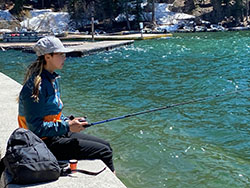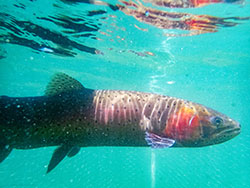Michael Mamola, CDFW’s Statewide Trout Management and Stocking Coordinator, shows off a Lahontan cutthroat trout before its release into Echo Lake earlier this spring.

The Lahontan cutthroat trout is the largest inland trout species in the world and the only trout native to the Lake Tahoe Basin.

Few visitors to Echo Lake pause to fish and probe the waters for the Lahontan cutthroat trout that live within.

Lahontan cutthroat trout grow large in Echo Lake, El Dorado County, thanks to the large population of forage fish, principally the Lahontan redside minnow.
California anglers looking to target the native but elusive Lahontan cutthroat trout may want to put Echo Lake in El Dorado County on their summer itinerary.
For the past several years, the California Department of Fish and Wildlife (CDFW) has managed the deep blue waters of Echo Lake exclusively as a Lahontan cutthroat trout sport fishery.
That’s the same fish that has turned Nevada’s Pyramid Lake and its monster-sized cutthroats into a global fishing destination and created a cult following at Heenan Lake in Alpine County among fly anglers looking to tangle with a trophy cutthroat.
Located just minutes off U.S. Highway 50 near South Lake Tahoe at an elevation of 7,500 feet, Echo Lake may offer California anglers their best chance to encounter the Tahoe Basin’s native trout species given the combination of an easy drive, a plentiful fish population supported through a generous stocking regimen, and wide-open fishing access without the restrictions on seasons, take or tackle methods found at some other Lahontan cutthroat trout fisheries.
Adding to the overall experience, Echo Lake receives relatively little fishing pressure. The 300-acre lake is best known as a jumping-off point for the southern portion of Desolation Wilderness. Few of those backcountry travelers, however, pause to wet a line at Echo Lake.
“It’s sort of a hidden gem,” says Mitch Lockhart, CDFW’s District Fisheries Biologist for El Dorado, Placer and Nevada counties. “You’ll not be combatting for space to fish here.”
Echo Lake received a recent stocking of 100 brood stock Lahontan cutthroat trout from nearby Heenan Lake. Resplendent in their crimson spring spawning colors, the fish ranged in size from two to nine pounds with an average weight of two to three pounds. CDFW followed up that trophy stocking with a plant of some 20,000 “sub-catchable” Lahontan cutthroat trout in the seven- to nine-inch range.
Echo Lake’s recent history as a Lahontan cutthroat trout fishery resulted from a collaboration between lakeside property owners and CDFW. Cabin owners were seeking improved fishing opportunities given recent cutbacks and elimination of hatchery stockings of rainbow trout, brown trout and brook trout. At the same time, CDFW fisheries biologists were looking for suitable locations to stock Lahontan cutthroat trout into their historic range in the Tahoe Basin and expose more anglers to the unique, native fish.
Echo Lake fit the criteria. Its steep-sided granite cliffs, clean, cold deep waters are reminiscent of Independence Lake in Nevada County and Fallen Leaf Lake in El Dorado County, two historic and active Lahontan cutthroat trout fisheries.
Echo Lake also is relatively isolated from other waters and protected from infiltration by non-native trout species. The lake holds some small, remnant populations of brook and brown trout with little opportunity for wild rainbow trout to access the lake and colonize it from surrounding waters. Displacement, hybridization and competition from non-native trout is largely what earned the Lahontan cutthroat trout listing under the federal Endangered Species Act 51 years ago and what mostly prevents large-scale recovery efforts today.
And unlike some other high Sierra lakes where trout eke out a meager existence in near-sterile conditions, Echo Lake is rich with food in the form of the Lahontan redside, a native minnow that has proven an important forage fish responsible for Lahontan cutthroat trout growth rates of two to three inches a year in Echo Lake.
Anglers reported catching Lahontan cutthroats to 26-inches last year with the average size being closer to 12 to 14 inches with an occasional 16-, 18- and 24-inch fish in the mix. CDFW biologists say they are seeing anecdotal evidence of natural spawning, but plan to manage Echo Lake primarily for recreational fishing and not species recovery.
CDFW has stocked two strains of Lahontan cutthroat trout into Echo Lake, the Pilot Peak strain of Pyramid Lake fame that can reach sizes in excess of 20 pounds, and the smaller Independence/Summit Lake strain of fish from eggs collected at Heenan Lake and raised at the American River Trout Hatchery outside of Sacramento.
A Lahontan cutthroat trout caught and documented from Echo Lake qualifies for CDFW’s Heritage Trout Challenge, which incentivizes and rewards anglers for catching six different forms of California native trout from their historic drainages.
In addition to easy drive-to access, Echo Lake features a popular marina, boat launch and convenience store where kayaks and canoes can be rented. Private boats and other waterfcraft can be launched only after mandatory inspection and certification that they are free of aquatic invasive species.
CDFW Creates Lahontan Cutthroat Trout Sport Fishery at Echo Lake (Video)
CDFW Photos: